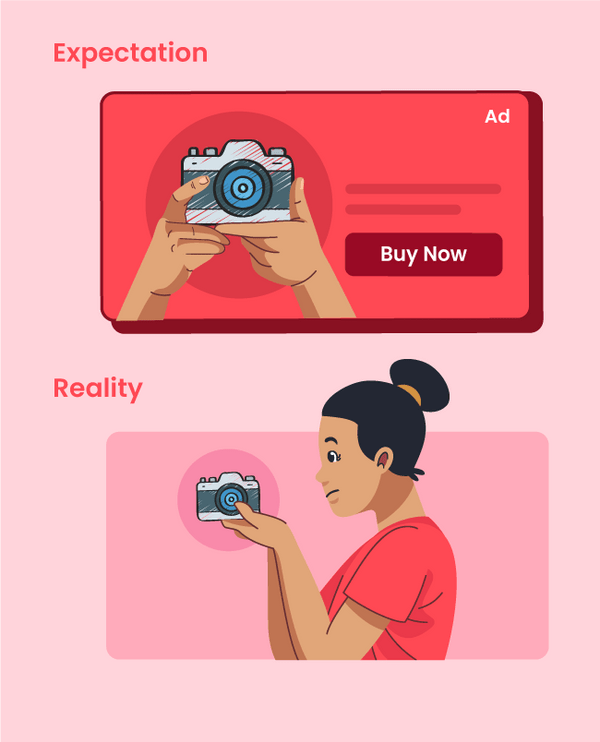Learn about misleading advertising examples and discover practical tips to avoid falling victim to deceptive marketing practices. Protect yourself from financial losses and make informed purchasing decisions. Read more.
In today’s fast-paced and competitive marketplace, consumers are bombarded with an abundance of advertisements vying for their attention. While advertising serves as a powerful tool for businesses to promote their products or services, there is an inherent risk of encountering misleading advertising.
In fact, estimations by Statista have revealed a startling trend in the world of digital advertising, predicting a significant and exponential rise in costs associated with advertising fraud. Within the span of four years, from 2018 to 2023, these costs are expected to surge from 35 billion to a staggering 100 billion U.S. dollars.
In this article, we will take a look at some common examples of misleading advertising and provide practical tips to help consumers navigate this complex landscape with confidence and skepticism. By empowering consumers with such a fallacy in advertising, we aim to promote a marketplace that prioritizes transparency, honesty, and consumer protection.
Before getting into the misleading advertising examples, let’s understand misleading advertising meaning.
What is Misleading Advertising?
False or misleading advertising represents digital or traditional propaganda that uses fraudulent or deceptive information to make a consumer act differently than they would have otherwise. In other words, false advertising is propaganda that exists to compel a consumer to purchase based on incorrect or deceptive information.
For instance, one could also consider advertising misleading if it left out vital information about a product or service. All of the above applies to various advertising and promotional mediums like magazines, catalogs, physical and digital advertisements, websites, etc
Also Read – 5 Common Types of Ad Fraud (and How They Affect Publishers)
What Are Some Misleading Advertisements Examples?
The most reliable way for consumers to protect themselves from false advertising is to learn how to recognize it and ignore it. Here are just some of the things that fall under the definition of false advertising:

Product Misrepresentation
First misleading advertising example in the list, product misinterpretation is very common and many of us have probably experienced this. Misrepresenting one’s product usually entails it looking different or having different qualities than stated in the ad. Brands most often misrepresent things like the product’s color, size, and look. They may also misrepresent their product’s health benefits, give it false attributes (like environmentally friendly), or inconsistently compare it to their competitors.
Hidden Fees
This category includes any extra fees that aren’t stated in an advertisement (e.g., shipping costs) or even products with falsely inflated prices so that the sellers could advertise them as on sale.
Business Misrepresentation
Fillers
This point applies to food ads since most manufacturers use fillers like oats and brine to inflate their products’ weight. So just because the ad says a burger is 100% beef doesn’t make it true!
Misuse of the Word “Free”
Be mindful of false associations with the word “free.” All “buy one, get one for free” deals are technically false advertising since nothing is free; you still have to pay for one product.
Advertising, when used correctly, can be an effective way to promote and sell products. It can provide consumers with the information they need to make a smart shopping decision. However, false advertising is harmful to both the consumer and the advertiser.
Now that you are aware of misleading advertising examples, let’s learn how to avoid falling prey to it.
Manipulative Testimonials and Endorsements
Another misleading advertising example is manipulative testimonials and endorsements, which are very common.
. These carefully crafted narratives, often presented as genuine experiences, aim to sway our judgment and lure us into making uninformed decisions. To protect ourselves from falling into this trap, we must sharpen our skepticism and develop the ability to identify these deceitful endorsements.
When encountering testimonials, it is crucial to approach them with a discerning eye. Look for red flags such as overly positive and exaggerated claims that seem too good to be true. Take note of generic statements lacking specific details or testimonials that sound scripted and lack authenticity.
How to Avoid Misleading Advertisements?
Ads are designed to make you buy something, and they often won’t fret about misrepresenting what they’re promoting. That is why you should never take them at their face value and be mindful not to fall prey to one of many advertising fallacies. Always think before you act.
Here are some steps you can take to avoid misleading advertising.
Researching and verifying product claims
In a marketplace flooded with extravagant claims and exaggerated promises, it becomes essential to become an informed consumer. Researching and verifying product claims can serve as a shield against deceptive advertising practices. It’s time to dive into the vast ocean of information, armed with search engines, customer reviews, and reputable sources. Through meticulous investigation, we can separate fact from fiction, uncovering the hidden truths behind the glossy advertisements that beckon us.
Seeking reliable sources and reviews
Navigating the treacherous waters of misleading advertising necessitates our reliance on reliable sources and reviews. While the internet offers a wealth of information, it also presents us with a minefield of misinformation. To combat this, we must don the armor of skepticism and wield the sword of discernment. By seeking out reputable sources, consulting experts, and exploring unbiased reviews, we can fortify ourselves against the siren call of misleading advertisements.
Being cautious of persuasive techniques and emotional appeals
As consumers, we find ourselves caught in the crosshairs of persuasive techniques and emotional appeals employed by cunning advertisers. To safeguard our judgment, we must develop a keen eye for these manipulative tactics. It’s crucial to recognize when our emotions are being exploited and separate genuine benefits from marketing ploys. By questioning the underlying motives of advertisements and maintaining a healthy level of skepticism, we can rise above the sea of persuasive tricks and make informed decisions.
Getting as much information about a product before considering a purchase is essential. And you won’t get that information from an ad. That is why browsing through customer reviews or testimonials is an excellent place to start.
Also Read – How to Detect Ad Fraud & Prevention Tips for Digital Publishers
Conclusion
By understanding the fine print, conducting thorough research, seeking reliable sources and reviews, and being cautious of persuasive techniques, we can empower ourselves to make informed decisions. It is essential to develop a healthy skepticism and critically evaluate the claims and endorsements presented to us. By doing so, we can safeguard our interests, save our hard-earned money, and ensure that our choices align with our true needs and preferences.
Remember, as consumers, we have the power to demand transparency, honesty, and accountability from advertisers.
Frequently Asked Questions on Misleading Advertising Examples
A quick example of misleading advertising is a toothpaste claiming to whiten teeth by several shades after just one use, when in reality, it may only provide minimal whitening effects over a more extended period of use.
An example of misleading sales is when a store advertises a limited-time discount on a product but fails to disclose that the original price was artificially inflated, making the discount seem more significant than it actually is. This can mislead consumers into thinking they are getting a better deal than they truly are.

Deepak has a keen eye for detail and a deep understanding of the ad tech landscape. Whether it’s through in-depth articles, thought-provoking insights, or compelling storytelling, he’s dedicated to helping people navigate the complex world of ad tech with the simplicity of his words.



![Top 12 Ad Networks in India Every Publisher Should Know [2024 Edition] Indian Ad Networks](https://www.adpushup.com/blog/wp-content/uploads/2019/09/undraw_Note_list_re_r4u9-270x180.png)



